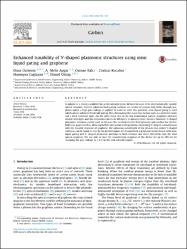| dc.contributor.author | Ozdemir, Onur | |
| dc.contributor.author | Aygar, A. Melis | |
| dc.contributor.author | Balci, Osman | |
| dc.contributor.author | Kocabas, Coskun | |
| dc.contributor.author | Caglayan, Humeyra | |
| dc.contributor.author | Ozbay, Ekmel | |
| dc.date.accessioned | 2020-02-05T07:14:54Z | |
| dc.date.available | 2020-02-05T07:14:54Z | |
| dc.date.issued | 2016 | en_US |
| dc.identifier.issn | 0008-6223 | |
| dc.identifier.other | 1873-3891 | |
| dc.identifier.other | 10.1016/j.carbon.2016.07.049 | |
| dc.identifier.uri | https://hdl.handle.net/20.500.12573/126 | |
| dc.description | This work is supported by the projects DPT-HAMIT, NATO-SET-193, TUBITAK-113E331, TUBITAK-114E374 and Research Fund of Abdullah Gul University Project Number FAB-2015-2. The authors (E.O. and H.C.) also acknowledges partial support from the Turkish Academy of Sciences. One of the authors (H.C.) also acknowledges partial support from "For Women in Science" fellowship by L'Oreal-Unesco Turkey. | en_US |
| dc.description.abstract | Graphene is a strong candidate for active optoelectronic devices because of its electrostatically tunable optical response. Current substrate back-gating methods are unable to sustain high fields through graphene unless a high gate voltage is applied. In order to solve this problem, ionic liquid gating is used which allows substrate front side gating, thus eliminating the major loss factors such as a dielectric layer and a thick substrate layer. On the other hand, due to its two dimensional nature, graphene interacts weakly with light and this interaction limits its efficiency in optoelectronic devices. However, V-shaped plasmonic antennas can be used to enhance the incident electric field intensity and confine the electric field near graphene thus allowing further interaction with graphene. Combining V-shaped nanoantennas with the tunable response of graphene, the operation wavelength of the devices that utilize V-shaped antennas can be tuned in situ. In the present paper, we demonstrate a graphene-based device with ionic liquid gating and V-shaped plasmonic antennas to both enhance and more effectively tune the total optical response. We are able to tune the transmission response of the device for up to 389 nm by changing the gate voltage by 3.8 V in the mid-infrared regime. (C) 2016 Elsevier Ltd. All rights reserved. | en_US |
| dc.description.sponsorship | Turkiye Cumhuriyeti Kalkinma Bakanligi Abdullah Gul University FAB-2015-2 Turkish Academy of Sciences "For Women in Science" fellowship by L'Oreal-Unesco Turkey NATO-SET-193 TUBITAK-113E331 TUBITAK-114E374 | en_US |
| dc.language.iso | eng | en_US |
| dc.publisher | PERGAMON-ELSEVIER SCIENCE LTD, THE BOULEVARD, LANGFORD LANE, KIDLINGTON, OXFORD OX5 1GB, ENGLAND | en_US |
| dc.relation.ispartofseries | Volume: 108; | |
| dc.relation.ispartofseries | Pages: 515-520; | |
| dc.rights | info:eu-repo/semantics/openAccess | en_US |
| dc.subject | CHARGE | en_US |
| dc.subject | LIGHT | en_US |
| dc.title | Enhanced tunability of V-shaped plasmonic structures using ionic liquid gating and graphene | en_US |
| dc.type | article | en_US |
| dc.contributor.department | AGÜ, Mühendislik Fakültesi, Elektrik & Elektronik Mühendisliği Bölümü | en_US |
| dc.contributor.institutionauthor | | |
| dc.identifier.doi | 10.1016/j.carbon.2016.07.049 | |
| dc.relation.publicationcategory | Makale - Uluslararası Hakemli Dergi - Kurum Öğretim Elemanı | en_US |


















